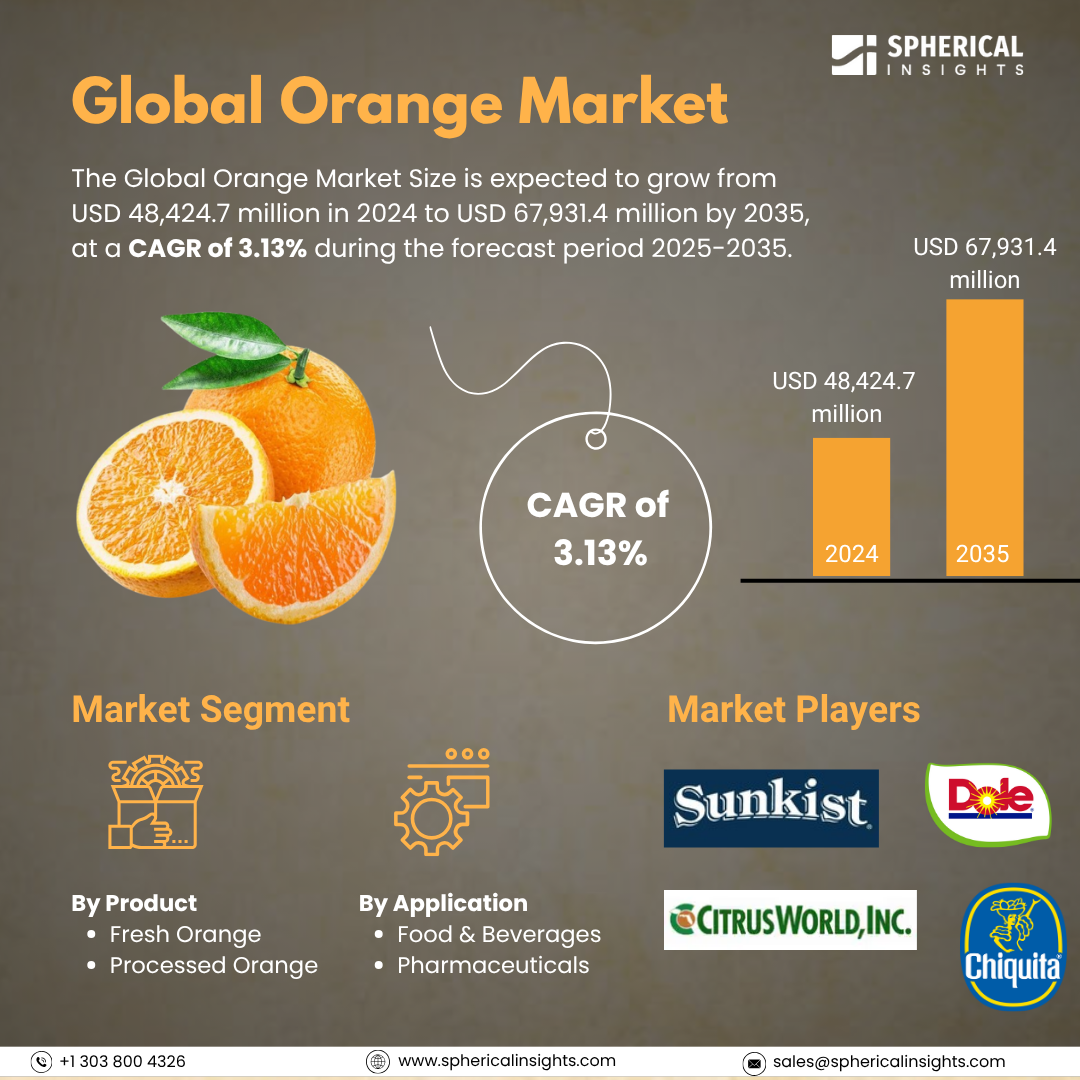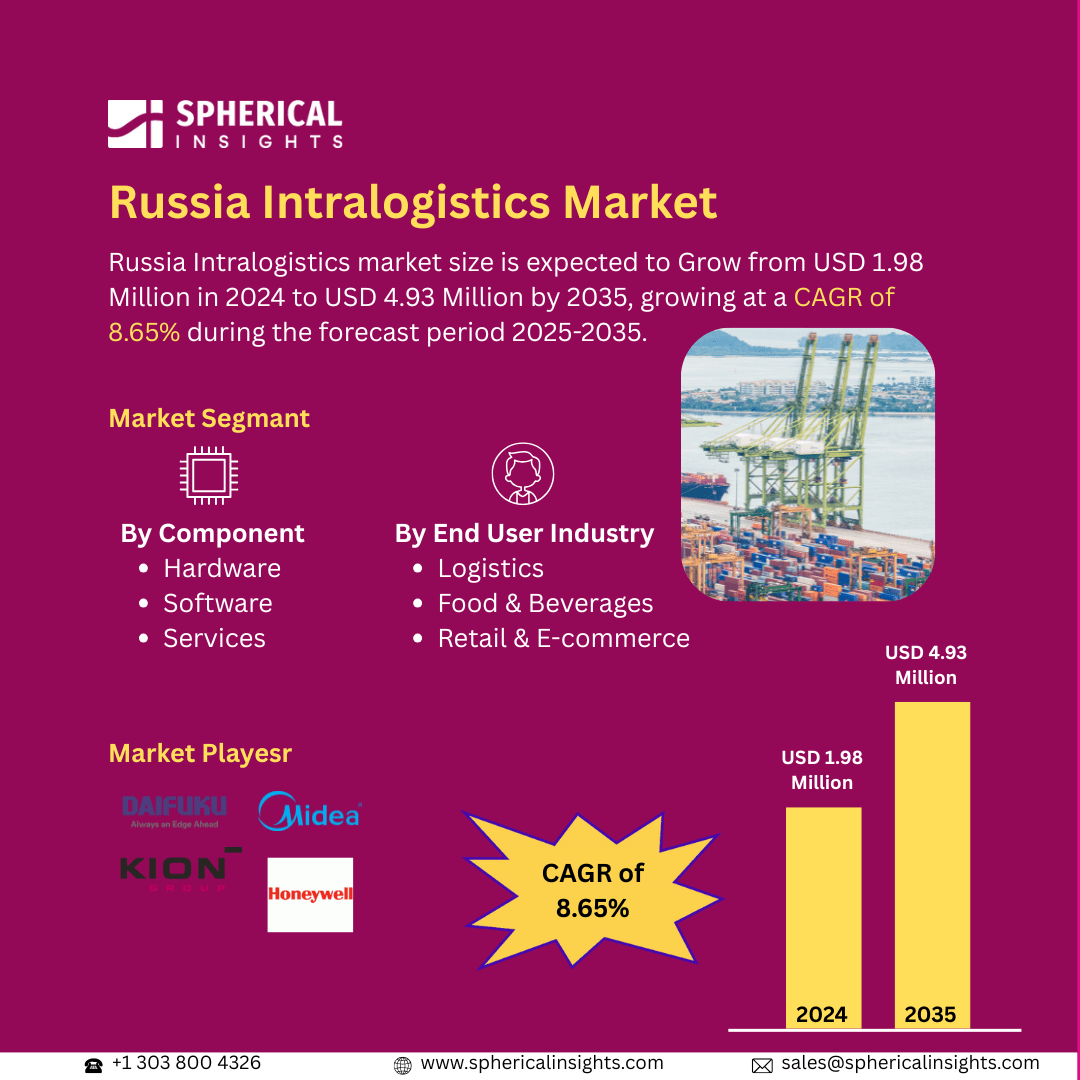Global Orange Market Insights Forecasts to 2035
- The Global Orange Market Size Was Estimated at USD 48,424.7 Million in 2024
- The Market Size is Expected to Grow at a CAGR of around 3.13% from 2025 to 2035
- The Worldwide Orange Market Size is Expected to Reach USD 67,931.4 Million by 2035
- Asia Pacific is Expected to Grow the fastest during the forecast period.
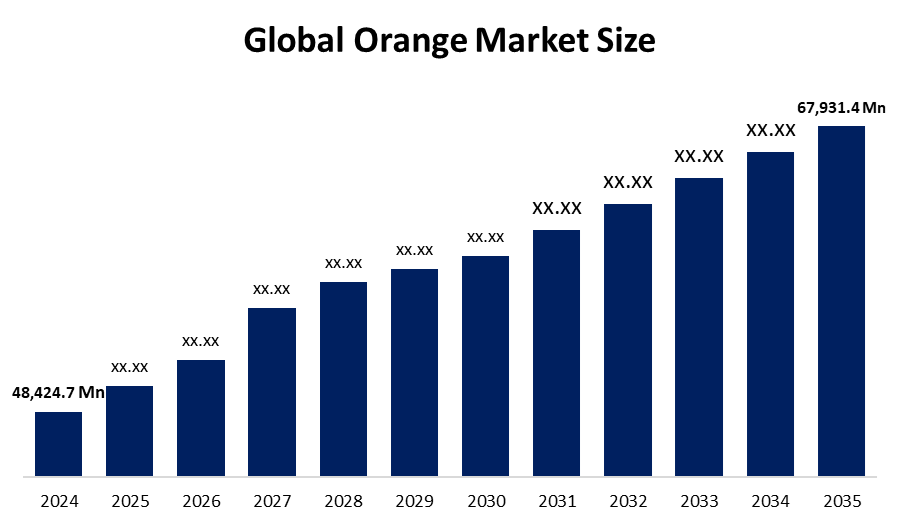
Orange Market
The global orange market covers the growing, processing, and selling of oranges, a fruit enjoyed worldwide for its sweet flavor and high vitamin C content. In 2023, around 50 million metric tons of oranges were produced globally. The leading producers are Brazil, the United States, India, China, and Mexico. These countries not only grow large amounts of oranges but also export them to other parts of the world. The market is mainly split into fresh oranges and processed products. Fresh oranges are mostly eaten as whole fruit, making up the largest part of the market. Processed products include orange juice, which is popular worldwide in both concentrated and fresh forms, as well as canned oranges and marmalades. Oranges grow in many different climates, and international trade helps supply areas where oranges are not grown locally. The orange market is important for both local economies and global trade.
Attractive Opportunities in the Orange Market
- Innovations in cultivation and pest management improve orange yields and fruit quality. Technologies like precision farming and better disease control help reduce losses from issues such as citrus greening, boosting overall production efficiency.
- Consumers increasingly seek convenient, ready-to-consume products like orange juices, snacks, and fortified beverages. Innovative packaging and new formats cater to busy lifestyles and growing health consciousness.
- Urbanization and higher disposable incomes in regions like Asia Pacific are driving demand for fresh and processed oranges. Growing health awareness further supports market growth in these emerging economies.
- E-commerce and digital marketing enable brands to reach more consumers directly, increasing sales opportunities. Enhanced trade partnerships and better logistics ensure fresh oranges and products reach new markets efficiently year-round.
Global Orange Market Dynamics
DRIVER: Urbanization and rising disposable incomes, especially in emerging markets
The global orange market is expanding due to several unique factors shaping consumer behavior and industry practices. Growing awareness about the health benefits of oranges, particularly their rich vitamin C and antioxidant content, has made them a favored choice among health-conscious consumers. There is also a noticeable shift towards fresh and organic produce, which has increased demand for fresh oranges in various regions. On the processed side, convenience plays a key role, with ready-to-drink orange juices and innovative packaging attracting busy consumers seeking nutritious options. Urbanization and rising disposable incomes, especially in emerging markets, are further driving consumption. Technological improvements in harvesting, storage, and transportation have enhanced the quality and availability of oranges year-round. Moreover, expanding international trade routes and better supply chain management enable producers to reach new markets efficiently.
RESTRAINT: Labor shortages and increasing farming expenses in some regions
Climate variability, including irregular rainfall and extreme weather events, disrupts orange cultivation and can lead to lower harvests. Additionally, diseases like citrus greening and fungal infections continue to threaten orchard health, raising production costs and affecting fruit quality. Market volatility, such as fluctuating prices and changing trade policies, creates uncertainty for producers and exporters. Labor shortages and increasing farming expenses in some regions further strain production efficiency. Consumer shifts toward other fruits and alternative beverages may also reduce demand for oranges in certain areas. Moreover, challenges in logistics, such as delays in transportation and inadequate storage facilities, can impact the freshness and timely delivery of oranges to markets. These combined factors contribute to difficulties in maintaining consistent supply and growth, posing significant challenges to the global orange industry’s overall stability and progress.
OPPORTUNITY: Advancements in farming techniques and disease control
Technological advancements in farming techniques and disease control can improve crop yields and fruit quality, boosting overall production. The trend toward convenience and on-the-go lifestyles opens doors for innovative products like ready-to-drink orange juices, citrus-based snacks, and fortified beverages. Emerging economies with rising urban populations and higher disposable incomes represent untapped markets eager for fresh and processed orange products. Additionally, the rise of online shopping and digital marketing allows brands to connect directly with consumers, increasing sales potential. Enhanced global trade partnerships and better transportation infrastructure further enable smoother distribution across borders. These combined opportunities position the orange market for steady expansion and product diversification in the years ahead.
CHALLENGES: Regulatory hurdles and varying quality standards
One significant issue is soil degradation in key growing regions, which reduces land productivity and increases the need for fertilizers and soil management techniques. Additionally, water scarcity in many citrus-growing areas places pressure on irrigation systems, raising production costs. The highly seasonal nature of orange harvesting can lead to supply gluts during peak periods and shortages off-season, complicating inventory management. Regulatory hurdles and varying quality standards across countries can also create barriers for exporters trying to enter new markets. Furthermore, packaging waste concerns and increasing demand for sustainable practices require producers to invest in eco-friendly solutions, which may involve higher upfront costs.
Global Orange Market Ecosystem Analysis
The global orange market ecosystem includes growers, suppliers, processors, distributors, retailers, and consumers. Major producers like Brazil and the U.S. cultivate oranges, supported by suppliers of fertilizers and equipment. Processors transform fresh fruit into juice and other products. Distributors and logistics providers handle transportation and storage, ensuring quality from farm to market. Retailers sell fresh and processed oranges to consumers worldwide. Exporters and importers enable international trade, while regulatory bodies set standards and policies. Research institutions contribute through innovations in cultivation and pest control, creating a connected network that drives the orange market globally.
Based on the product, the fresh oranges segment held the highest revenue share and is expected to grow at a significant CAGR during the forecast period
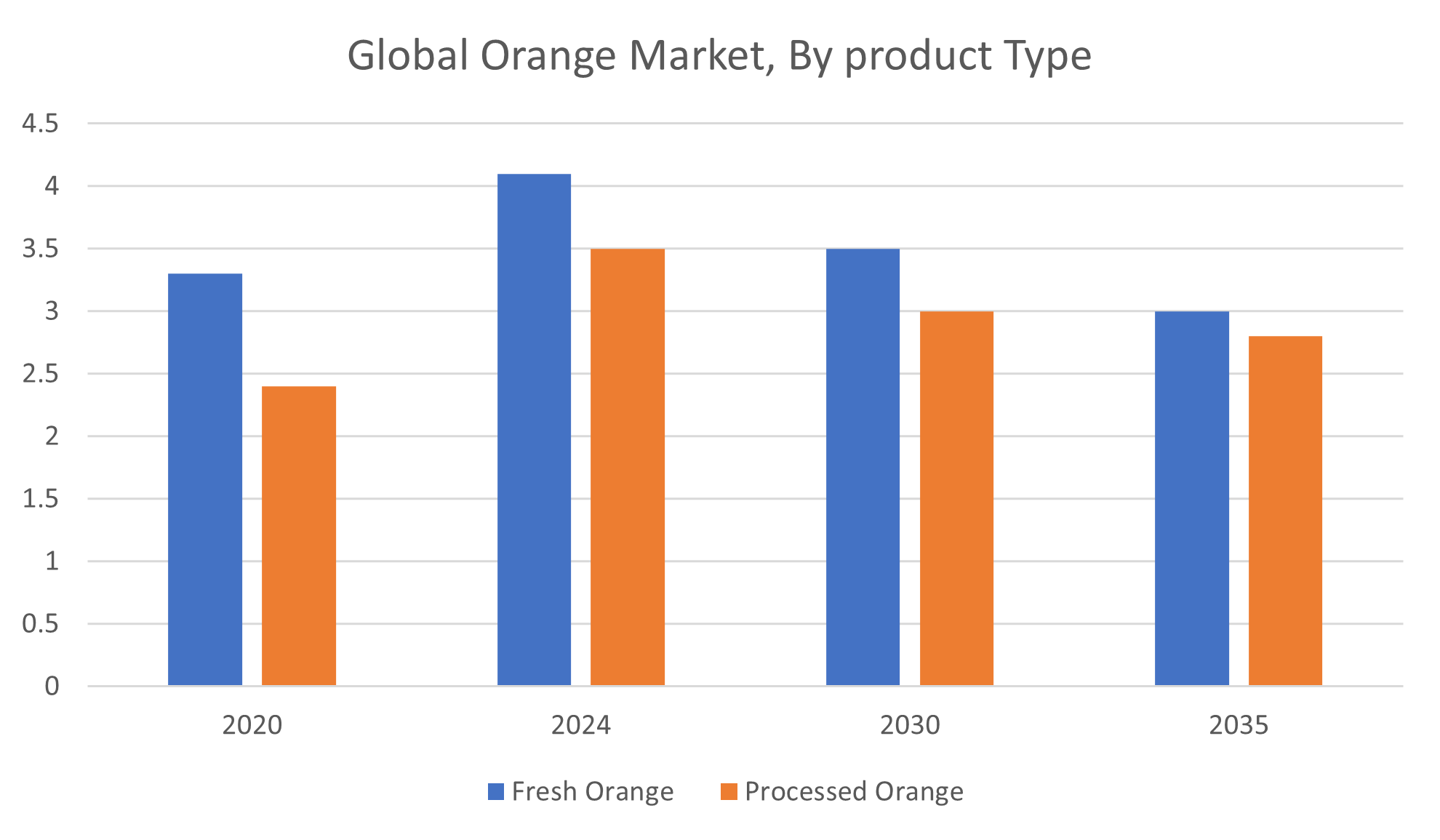
Oranges are full of vitamins and fiber, which helps keep people healthy. Fresh oranges can be eaten on their own or used in different recipes, so they are very popular in homes and restaurants. Better ways to harvest, pack, and transport oranges have made it easier to keep them fresh for longer. Also, as more people in growing countries have higher incomes, they are buying more fresh fruit like oranges. Because of these reasons, the fresh orange segment is expected to grow steadily in the coming years.
Based on the application, the food & beverages segment accounted for the highest revenue share and is expected to grow at a remarkable CAGR during the forecast period
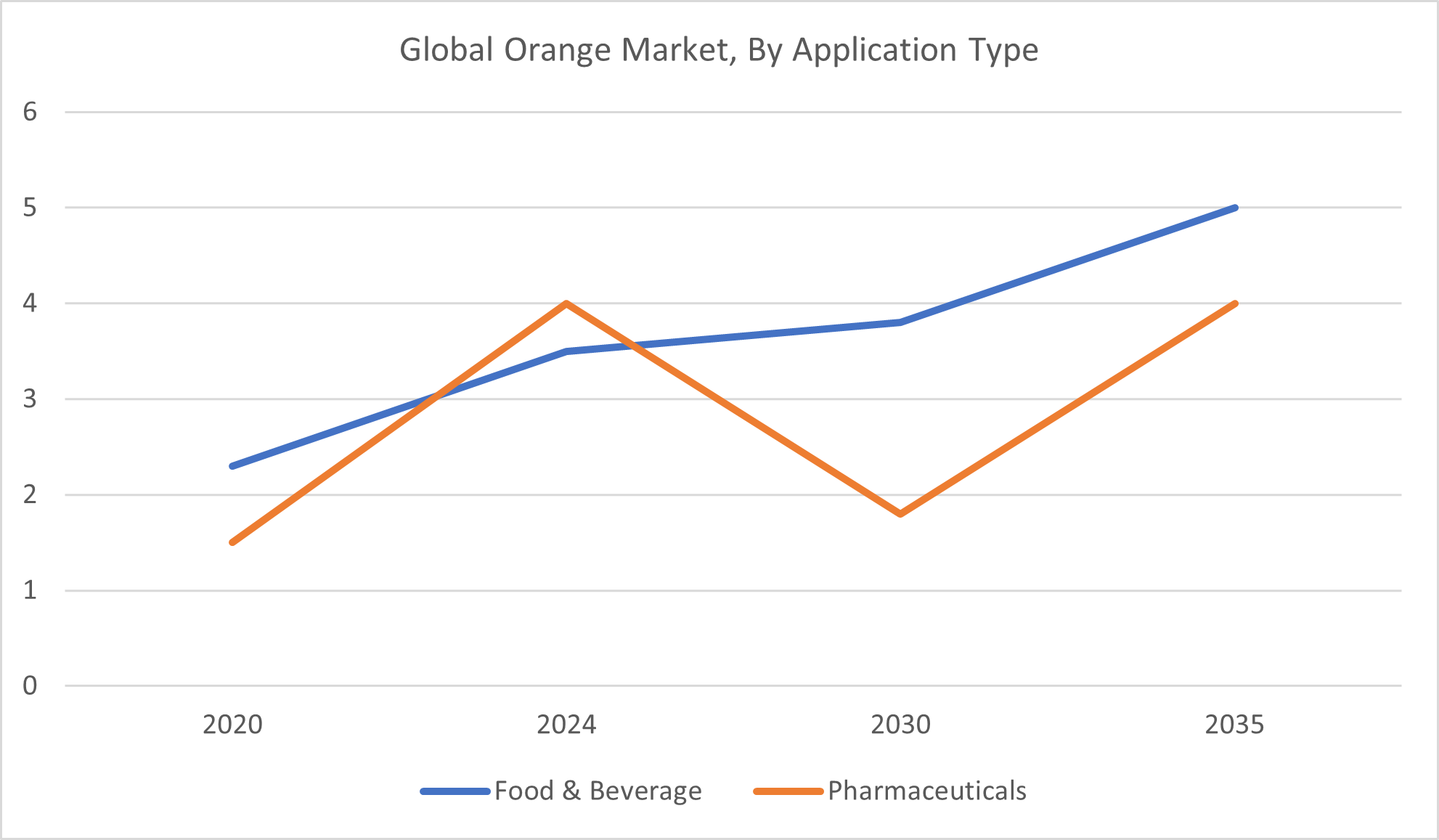
Oranges are a key ingredient in many food items like desserts, salads, sauces, and snacks, as well as in beverages such as fresh orange juice, concentrates, and flavored drinks. The demand for natural and healthy ingredients in food and drinks is increasing, which boosts the use of oranges in this sector. Additionally, innovations in ready-to-drink juices and convenient orange-based products are attracting more consumers. This growing preference for nutritious and tasty options is driving strong demand for oranges in the food and beverage industry worldwide.
North America is anticipated to hold the largest share of the orange market during the forecast period
The region has a strong consumer demand for fresh fruits and orange-based products, driven by the popularity of oranges for their taste and health benefits, particularly their high vitamin C content. The United States is a major player in the global orange juice industry, with consistent demand supporting market growth. Additionally, advanced agricultural practices and infrastructure in North America contribute to high-quality production and efficient supply chains, ensuring year-round availability. Growing health and wellness trends further boost demand as consumers increasingly seek nutritious and natural food options. Furthermore, the presence of well-established retail networks and robust import-export activities helps maintain a steady supply, solidifying North America’s dominant position in the orange market.
Asia Pacific is expected to grow at the significant CAGR in the orange market during the forecast period
Asia Pacific is expected to grow at a significant compound annual growth rate (CAGR) in the orange market during the forecast period. This growth is fueled by increasing health consciousness among consumers, rising disposable incomes, and rapid urbanization in key countries such as China, India, and Southeast Asian nations. The expansion of modern retail formats and improvements in cold chain logistics have enhanced the availability and quality of fresh oranges and orange-based products. Additionally, growing demand for orange juice and processed products, along with supportive government policies to boost agriculture and fruit consumption, are contributing to the robust market growth in the region.
Key Market Players
KEY PLAYERS IN THE ORANGE MARKET INCLUDE
- Sunkist Growers, Inc.
- Citrus World, Inc. (Florida’s Natural Growers)
- Dole Food Company, Inc.
- Chiquita Brands International, Inc.
- Limoneira Company
- The Wonderful Company (Frieda’s Inc.)
- Sicilian Citrus Growers Cooperative
- Del Monte Foods, Inc.
- Tropicana Products, Inc. (PepsiCo subsidiary)
- Vitao Group
- Others
Market Segment
This study forecasts revenue at global, regional, and country levels from 2020 to 2035. Spherical Insights has segmented the orange market based on the below-mentioned segments:
Global Orange Market, By Product
- Fresh Orange
- Processed Orange
Global Orange Market, By Application
- Food & Beverages
- Pharmaceuticals
Global Orange Market, By Regional Analysis
- North America
- Europe
- Germany
- UK
- France
- Italy
- Spain
- Russia
- Rest of Europe
- Asia Pacific
- China
- Japan
- India
- South Korea
- Australia
- Rest of Asia Pacific
- South America
- Brazil
- Argentina
- Rest of South America
- Middle East & Africa
- UAE
- Saudi Arabia
- Qatar
- South Africa
- Rest of the Middle East & Africa
